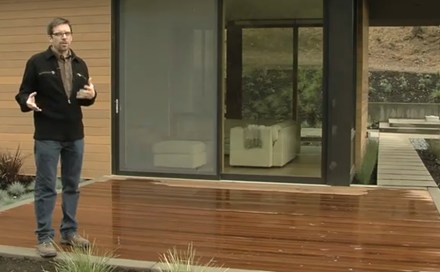Ipe Wood Deck Design
See how and why wooden ipe decks were incorporated into the design of this modern landscape.
A video transcript featuring Joseph Huettl, Huettl Landscape Architecture
This project, in addition to the colored concrete squares for certain areas of the patio, we decided to go with a change of material, and the material we chose was an ipe hardwood decking. It's very durable, and it's very modern. We kept the decking flush with the grade, and that was very important. We didn't want to have the standard floating raised deck. We wanted to keep it flush with the rest of the paving. We achieved that by excavating out soil and providing drainage underneath, and then we have a perimeter of the same-colored concrete that retains the soil back and provides a nice visual border.
We placed these two deck areas. There's one in the back, and one in the front here. They associate with the wood flooring of the house. Other areas of the house have tile flooring. It has a sort of a beige earthtone, and that coincides with the concrete areas. And then the wood flooring of the house we carried out into the landscape with the flush ipe decking.
Installing a flush deckWhen you're doing a flush deck like this, it's important that you're not just laying the wood right on the ground. That's just not going to last; it's not the proper way to do it. You do have to allow for the proper airflow underneath the deck and the substructure, as well as drainage. Once you excavate out for a deck, you're creating a low point and water will accumulate there.
We have very good drainage We have a gravel layer with two catch basins underneath the decking. You can really only do this if you have enough fall to get the drainage piping that has to be lower than your substructure out to grade somewhere. If you have those conditions, it's a really nice effect to have a hardwood. It feels more like a floor when it's at grade as opposed to raised up where it feels like an empty deck. This just has more of that nice, hardwood floor effect.
Pros and cons of using ipeWhen using ipe, one of the caveats is it's a very durable wood. It doesn't scratch easily. It lasts a very long time. I don't even know if they know its lifespan yet. There are decks made of it, there are boardwalks made of it -- I guess in Atlantic City -- that have still held up over time. The downside is that it's so dense that it doesn't absorb a stain very well. Very hard for it to take a stain, and so if you choose to seal it or stain it, even with the better products out there, it still seems to be every one or two years that you have to restain it. If you don't choose to stain it, it'll still last. It'll just go kind of silver-gray.
And then the other caveat with ipe wood is that even though it's very hard, very durable, it's what you would call "unstable" wood. It wants to move, it wants to warp, so your connections have to be very strong. Frequently we top screw it with stainless steel screws. You can use a finish-head screw to create a nice screwing pattern, and it's something you might be able to reverse. The fasteners we used consisted of a small plastic biscuit that fits into the side groove onto the edges of the ipe wood, and then that is screwed down into the joints. Then you place the next board right under that flush so you're not really seeing screws on the surface of the deck.






